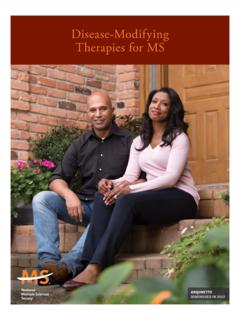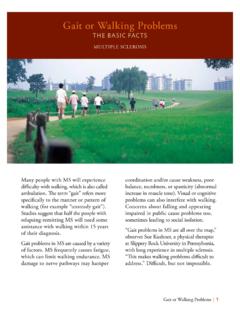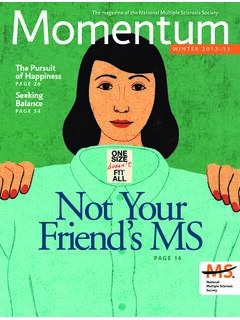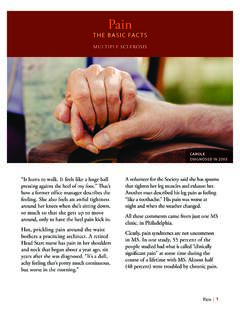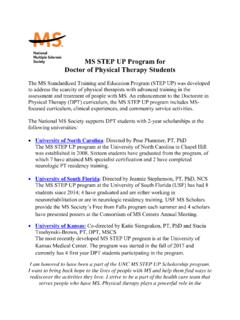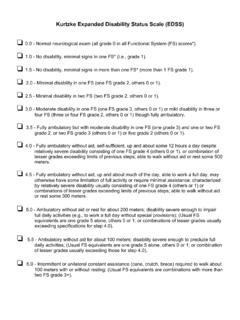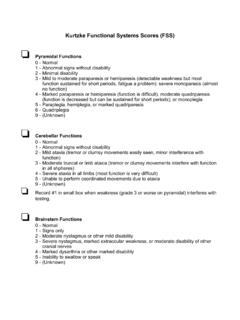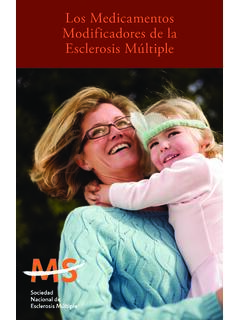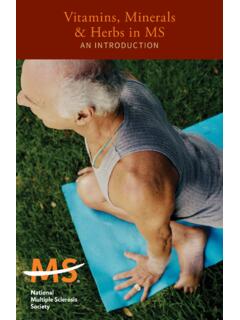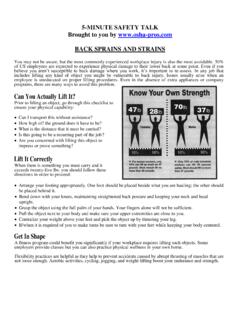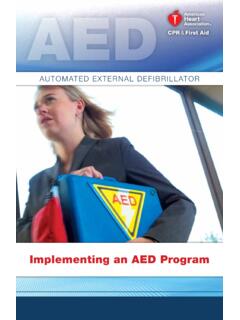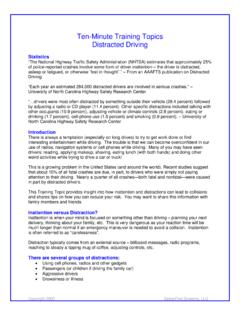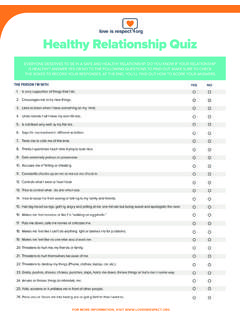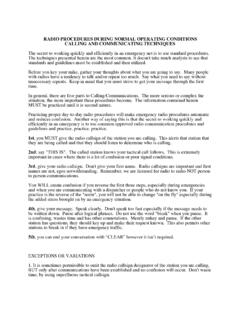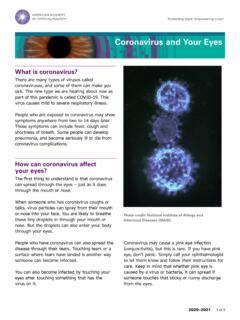Transcription of AN ILLUSTRATED MANUAL - National Multiple Sclerosis …
1 Stretching for People with MS. AN ILLUS T R AT ED M AN UAL. MICHELLE. DIAGNOSED IN 2001. Stretching for People with MS. AN ILLUS T R AT ED M AN UAL. BY: BETH GIBSON, PT. Beth Gibson, PT, graduated from the Mayo School of Health Related Sciences in Rochester, Minnesota, and had been working with people living with MS for 20 years. Special thanks to Susan Kushner, MS, PT; Cindy Hugos, MS, PT; Cindy Gackle, OTR/L, MSCS; and Brian Hutchinson, PT, MSCS; for their valuable assistance. Drawings by iMageWorx. Some of these drawings originally appeared in Multiple Sclerosis : A Self-Care Guide to Wellness, published in 1998 by Paralyzed Veterans of America, Inc. They are reproduced here with the kind permission of PVA, Inc. Additional images produced by Nicola Fester, 2011.
2 2016 National MS SOCIET Y. ALL RIGHTS RESERVED. Contents General 1. Summary of Special 2. Positioning for Managing 4. Some Precautions, Both Obvious & Not So 8. Head & Neck 9. Shoulder 11. Shoulder Range of Motion 13. Elbow & Forearm 14. Hand & Wrist 15. Trunk & Hip 18. Ankle & Foot 22. Sitting Coordination & Balance 24. General With decreased flexibility, contractures may occur that can be painful and significantly Introduction limit range of motion to a joint. The lack of flexibility and normal range of motion can Everyone with MS, regardless of his or her contribute to muscle imbalances, postural degree of ability or disability, needs regular problems and asymmetries, and falls. physical activity. Lack of exercise has serious health consequences, ranging from joint Strengthening contractures, to heart disease to constipation.
3 Strengthening is increasing the force or power Just as important, good exercise programs of the muscle. Strength can be increased not only prevent problems, they promote a by lifting a limb up against gravity, lifting sense of achievement and well-being. weights, or by working against resistance This booklet focuses on the basics to such as weights, machines, rubber tubing, move and gently stretch muscles and or even water. Strengthening exercises can other soft tissues, such as tendons, on help reduce fatigue. Exercises can be done in your own, at your own pace. For the 3 sets of 3 5 repetitions, more if tolerated. purposes of this book, the familiar term stretching is used, though most of these Cardiovascular Fitness exercises are, technically, range of motion Improving cardiovascular fitness helps to activities.
4 Shown are exercises that can be increase the amount of exercise and activity done sitting or on your bed. In addition one can do, thereby helping to manage weight to the four categories of exercise defined and blood lipid ( , cholesterol and triglyceride). below, everyone also needs relaxation. levels. Aerobic exercise makes lungs and all Exercise can be broken down into five muscles work harder, building endurance and categories, one of which is relaxation. reducing the risk of heart disease. Walking, All are important to people with MS. swimming, or using a stationary bike are forms of endurance activities. Adaptive sports Flexibility may also be possible. You may want to discuss Flexibility is stretching the muscle and your aerobic options with a knowledgeable tendon to its full length and moving the physical therapist.
5 Joint through its full range. These activities General guidelines for aerobic activity are decrease muscle tightness and prevent loss for 15 20 minutes a day, 4 5 times a week. of full range of motion which may occur with If that is not possible, any amount of activity decreased activity, weakness, or spasticity. is better than none. If can also be broken up Hold stretches for 30 40 seconds, as tolerated. into several shorter bouts throughout the day. National MS Society | 1. Balance & Coordination Summary of Balance and coordination is improving quality, safety and efficiency of movement. Special Terms Specific arm, leg and trunk exercises can be incorporated to improve the quality Your physician or physical therapist may of movement and allow for less energy use the following technical terms: expenditure to occur.
6 Activities for balance and coordination can be done on Range of Motion land or in the water. Yoga and Tai Chi are Range of motion is the extent of movement examples of specific activities for balance that is possible within a joint. and coordination that are beneficial when done properly. Can be done in 3 sets of 5. repetitions, as tolerated. Passive Range of Motion Passive range of motion is the extent of Relaxation motion possible in a joint when moved with assistance ( , by a therapist, helper, Relaxation is taking action to reduce physical or a piece of machinery). and mental stress and tension. Relaxation can simply mean stopping and taking a deep breath or sitting while listening to soft Active Range of Motion music or doing yoga. Structured relaxation Active range of motion is the extent of techniques can reduce fatigue from an exercise movement that is possible in a joint when session or help manage a stressful day.
7 The the person moves without assistance. National MS Society's booklet Taming Stress in MS contains directions for several kinds Active Assisted Range of Motion of structured relaxation exercises. The patient is doing part of the work and is being assisted by the helper. 2 | Stretching for People with MS. Spasticity Basic Exercise Movements Spasticity is tightening or stiffness of the See descriptions below. muscle due to increased muscle tone and exaggerated response to muscle stretch. Flexion Flexion is the act of moving a joint so that Joint Contractures your limb or trunk is bending. Usually the muscle is shortening. Join contractures are a limitation in the range of motion that impairs the Extension function of a joint. Extension is the act of moving a joint so that your limb or trunk is straightening out.
8 Disuse Muscle Atrophy Usually the muscle is lengthening. Disuse muscle atrophy is the decrease in size Abduction and eventually in strength of muscle Abduction is the act of moving a joint fibers that have not been contracted for a so that your limb is moving away from period of time. the middle of the body. Adduction Adduction is the act of moving a joint so that your limb is moving toward the body. National MS Society | 3. When exercising, try to keep your head Positioning for n straight (not tilted to one side). Managing Spasticity n If you are using a spasticity-reducing drug, time exercise to begin approximately one hour after taking the medication. Spasticity n Your antispastic drug dose should be Spasticity can be defined as a tightening or checked frequently, as spasticity changes.
9 Stiffness of the muscle due to increased muscle n Sudden changes in spasticity may occur tone, and is often made worse when muscles in the presence of infections, skin sores, are quickly stretched or moved. It can be one of or even tight shoes or clothing. the most common and frustrating symptoms of MS and can interfere with normal functioning. Positions Seen with Spasticity It can also greatly increase fatigue. However, & Ways to Decrease Spasticity exercise, properly done, is vital in managing spasticity. Keep in mind that you want to refrain from active exercises that accentuate a position The Following Tips May Prove Helpful: associated with any spasticity you experience. n Avoid positions that make your spasticity For example, if you have extensor spasticity, worse.
10 Refrain from doing the active exercises that n Daily stretching of muscles to their full straighten the hip and knee to the extent length will help to manage the tightness of that it sets off the spasticity. spasticity, and allow for optimal movement. It is important to remember that the positions n Keep in mind that moving a spastic muscle in this section are designed to decrease your to a new position may result in an increase spasticity. If they do not, consult your physician in spasticity. If this happens, allow a few or physical therapist. minutes for the muscles to relax. 4 | Stretching for People with MS. Spasticity Positions These are positions that the body tends to move towards when spasticity is dominant. Flexor Spasticity Common in people with Multiple Sclerosis .
